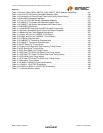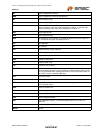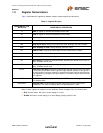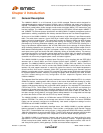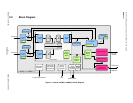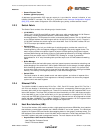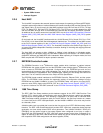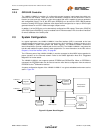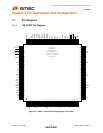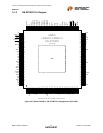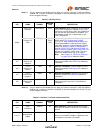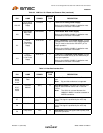
Two Port 10/100 Managed Ethernet Switch with 16-Bit Non-PCI CPU Interface
Datasheet
SMSC LAN9311/LAN9311i 23 Revision 1.4 (08-19-08)
DATASHEET
General Purpose Timer
Software (general purpose)
A dedicated programmable IRQ interrupt output pin is provided for external indication of any
LAN9311/LAN9311i interrupts. The IRQ pin is controlled via the Interrupt Configuration Register
(IRQ_CFG), which allows configuration of the IRQ buffer type, polarity, and de-assertion interval.
2.2.3 Switch Fabric
The Switch Fabric consists of the following major function blocks:
10/100 MACs
There is one 10/100 Ethernet MAC per switch fabric port, which provides basic 10/100 Ethernet
functionality, including transmission deferral, collision back-off/retry, TX/RX FCS
checking/generation, TX/RX pause flow control, and transmit back pressure. The 10/100 MACs act
as an interface between the switch engine and the 10/100 PHYs (for ports 1 and 2). The port 0
10/100 MAC interfaces the switch engine to the Host MAC. Each 10/100 MAC includes RX and
TX FIFOs and per port statistic counters.
Switch Engine
This block, consisting of a 3 port VLAN layer 2 switching engine, provides the control for all
forwarding/filtering rules and supports untagged, VLAN tagged, and priority tagged frames. The
switch engine provides an extensive feature set which includes spanning tree protocol support,
multicast packet filtering and Quality of Service (QoS) packet prioritization by VLAN tag, destination
address, and port default value or DIFFSERV/TOS, allowing for a range of prioritization
implementations. A 1K entry forwarding table provides ample room for MAC address forwarding
tables.
Buffer Manager
This block controls the free buffer space, multi-level transmit queues, transmission scheduling, and
packet dropping of the switch fabric. 32K of buffer RAM allows for the storage of multiple packets
while forwarding operations are completed. Each port is allocated 1a cluster of 4 dynamic QoS
queues which allow each queue size to grow and shrink with traffic, effectively utilizing all available
memory. This memory is managed dynamically via the Buffer Manager block.
Switch CSRs
This block contains all switch related control and status registers, and allows all aspects of the
switch fabric to be managed. These registers are indirectly accessible via the memory mapped
system control and status registers
2.2.4 Ethernet PHYs
The LAN9311/LAN9311i contains three PHYs: Port 1 PHY, Port 2 PHY and a Virtual PHY. The Port 1
& 2 PHYs are identical in functionality and each connect their corresponding Ethernet signal pins to
the switch fabric MAC of their respective port. These PHYs interface with their respective MAC via an
internal MII interface. The Virtual PHY provides the virtual functionality of a PHY and allows connection
of the Host MAC to port 0 of the switch fabric as if it was connected to a single port PHY. All PHYs
comply with the IEEE 802.3 Physical Layer for Twisted Pair Ethernet and can be configured for full/half
duplex 100 Mbps (100BASE-TX) or 10Mbps (10BASE-T) Ethernet operation. All PHY registers follow
the IEEE 802.3 (clause 22.2.4) specified MII management register set.
2.2.5 Host Bus Interface (HBI)
The Host Bus Interface (HBI) module provides a high-speed asynchronous SRAM-like slave interface
that facilitates communication between the LAN9311/LAN9311i and a host system. The HBI allows
access to the System CSRs and handles byte swapping based on the dynamic endianess select. The
HBI interfaces to the switch fabric via the Host MAC, which contains the TX/RX Data and Status FIFOs,
Host MAC registers and power management features. The main features of the HBI are:
Asynchronous 16-bit Host Bus Interface
- Host Data Bus Endianess Control
- Direct FIFO Access Modes



